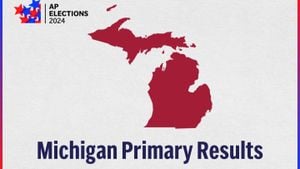The 2024 United States presidential election campaign has entered its final stretch, and the atmosphere is charged with energy and anticipation. Both major party candidates, Vice President Kamala Harris and former President Donald Trump, are pouring their efforts, thoughts, and rhetoric out onto the campaign trail, with the stakes ever visibly high as election day approaches. With just days left, the candidates are making bold assertions and pointed critiques directed at one another, highlighting the differences between their approaches to governance, issues of concern, and the image each presents to voters across the country.
Both candidates made significant stops on the campaign trail recently, each attempting to gain momentum among swing state voters who usually hold the key to victory. Harris held rallies aimed at bolstering unity, invoking themes of collaboration yet faced challenges concerning her closing arguments amid comments from President Biden. Trump, on the other hand, focused his attention on energizing his base, employing controversial remarks about protecting women, drawing on his contentious political history. His message has been described by critics as paternalistic, yet his supporters believe it encapsulates his commitment to American families.
During their campaign blitzes, Harris emphasized her commitment to addressing the concerns of working-class Americans. At one of her Las Vegas events, she was joined by singer Jennifer Lopez, who helped her rally the crowd, echoing her promise to “fight for working people.” Meanwhile, Trump leveraged every opportunity to repeat claims of widespread election fraud, which independent analysts have found to lack merit. His efforts to raise these allegations seemed to galvanize support among his followers, who feel emboldened by his rhetoric.
Voter turnout statistics have set new records, surpassing previous early voting figures from 2020, with over 65 million ballots already cast across the country. This has raised excitement and anxieties alike within both camps, illustrating just how tight this election could be.
Trump’s rallies have taken on unique challenges, such as dealing with competing narratives surrounding voter registration issues. He often casts the election as flawed, with reports highlighting suspicious registrations transformed by him and his allies to fit their narrative, even as local election officials insist their investigations are routine and meaningful. This tactic raises questions about the integrity of the election process, something Trump remains adamant about, aiming to capture voter fears as he crafts his campaign message.
On Harris’s side, efforts have been made to appeal to voters who might be disillusioned with Trump. Amid the hustle on the campaign trail, discussions about abortion rights and immigration policies have come to the forefront. Supporters of Harris pointed out how they resonate with her respectful stance on the immigration process and how she could uphold the law without resorting to past controversial measures. Many of her rallies have included calls for both comprehensive immigration reform and respect for the due process of law, presenting her as measured yet passionate.
Yet, as Trump challenges the status quo, he's faced derision for his approach, particularly remarks from rallies where he has accused voting preferences as opposing to the American standard. His declaration to protect women, “whether they like it or not,” has drawn attention for its confrontational undertones, especially for women voters. Paired with Harris's rhetorical strategies, these moments are pivotal, illustrating the divide each campaign hopes to exploit among the populace.
Through their intertwined journeys across pivotal states like Michigan, Wisconsin, and Pennsylvania—geographically and politically important to the election—the candidates underline the influence of battleground states. The Harris campaign has been addressing fringe concerns echoed by previous making headlines, attempting to draw contrasts between her vision as inclusive and supportive, against Trump’s echoed claims of standing against outsiders.
Another intriguing element has emerged during this election featuring Robert F. Kennedy Jr., who, at recent events, has positioned himself as someone who could take on significant health responsibilities should Trump win the presidency again. This assertive posture aligns with the interests of many voters questioning health issues and the credibility of pharmaceutical companies. Kennedy’s remarks suggest he aims to root out corruption and corporate alignment within the public health sector, pledging to protect American citizens from overreach and malformation within such agencies. The dynamics of this developing relationship with Trump could alter voter perceptions toward both candidates.
Complications abound for these candidates, not just from their rival campaigns but with the narratives formed around each statement made on the trail. The political climate has emboldened supporters to respond vigorously, leading to incidents of unrest. Most prominently, one concerning incident occurred where pro-Harris supporters faced intimidation tactics at voting sites—illuminifying the charges surrounding increased contention from both camps leading up to election day.
Political analysts observe this contest not merely as one of ideas but also as one of emotional appeal and identity politics. Trump continues to tap deeply barren wounds for resonance within his core supporters, often using incendiary rhetoric aimed at characterizing Democrats negatively. This approach has extended to his campaigning efforts and significantly shapes the conversation surrounding voter class, national identity, and what it means to be American under his vision.
With media attention focused heavily on swing states and key demographics like women voters, every appearance, comment, and action is closely examined for its potential electoral repercussions. Candidates deploy strategic attacks aimed toward one another’s electorate to flip independents and undecideds, each charge adding layers to the prevailing narrative.
Vice President Harris has also faced obstacles due to controversial comments made by President Biden, leading her to clarify her stance and seek distance from them. By illustrating her support for bipartisanship and emphasizing her role as advocate for all sides of the aisle, she hopes to mend any potential rifts among voter bases. She has rounded out her rallies by candidly addressing issues related to immigration policy, women’s rights, and economic recovery, promoting her executive experience.
Overall, as the countdown to the election dwindles, both campaigns ramp up messaging and local appearances with unprecedented intensity. With just days left until November 8th, public interest remains at fever pitch as candidates vie not just for votes but to define themselves against one another. This rivalry culminates not merely within the structures of traditional campaigning but lays bare the rawness of current American socio-political dynamics as opinions are tested and forms shift under the pressures of existing presumptions against new realities. Both campaigns promise to leave no stone unturned as they approach one of the most consequential election days this country has witnessed. The role of public sentiment will remain pivotal, informing which narrative resonates most deeply with the electorate and, when the dust settles, which path they choose for the future of the nation.



